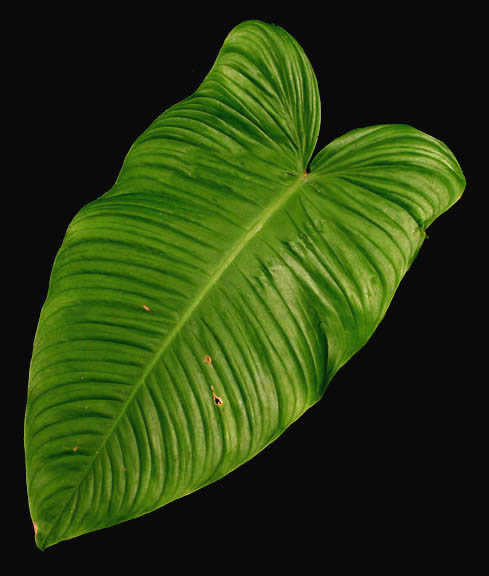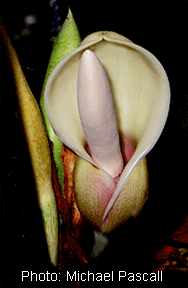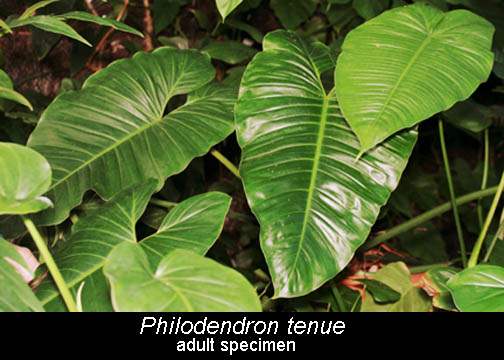![]()
Aroids and other genera in the Collection
Take the Tour Now?
Orchids
The
Exotic Rainforest
Plants in
the Exotic Rainforest Collection
Images on this website are copyright protected. Contact
us before any reuse.
In depth information on how to grow Philodendron species, Click this Link
Within our collection we have many species of Philodendron. If you are seeking other photos, click this link

Philodendron tenue K. Koch & Augustin
Philodendron ecuadorense, Philodendron gracile, Philodendron sodiroanum
 Philodendron tenue
is normally found as a hemiepiphytic climbing vine. A
hemiepiphyte (hem-a-EPA-fit) is a species that can begin life by climbing a
host tree or as a seed placed on a branch in a bird's droppings that
eventually grows roots to the ground. The species
is rarely either
terrestrial or purely epiphytic. An epiphyte (ep-a-FIT) is simply a species
that grows attached to another plant such
as a tree.
Philodendron tenue
is normally found as a hemiepiphytic climbing vine. A
hemiepiphyte (hem-a-EPA-fit) is a species that can begin life by climbing a
host tree or as a seed placed on a branch in a bird's droppings that
eventually grows roots to the ground. The species
is rarely either
terrestrial or purely epiphytic. An epiphyte (ep-a-FIT) is simply a species
that grows attached to another plant such
as a tree. rarely found in tropical wet rain forests. In Colombia it has
been collected as high as 2300 meters (7500 feet) and in Ecuador to 1930
meters (6300 feet). Obviously, P. tenue is found at many
elevations and can be found in both very dry forest as well as tropical
wet rain forests. The species is found as far south as central
Peru. P. tenue is a member of Philodendron section
Philodendron, subsection Philodendron ser. Fibrosa
partially due to its persistent cataphyll fibers.
The cataphylls are bract like
modified leaves that surround a new leaf and whose purpose is to protect
the newly emerging leaves as they develop.
rarely found in tropical wet rain forests. In Colombia it has
been collected as high as 2300 meters (7500 feet) and in Ecuador to 1930
meters (6300 feet). Obviously, P. tenue is found at many
elevations and can be found in both very dry forest as well as tropical
wet rain forests. The species is found as far south as central
Peru. P. tenue is a member of Philodendron section
Philodendron, subsection Philodendron ser. Fibrosa
partially due to its persistent cataphyll fibers.
The cataphylls are bract like
modified leaves that surround a new leaf and whose purpose is to protect
the newly emerging leaves as they develop.
 Philodendron tenue is
capable of producing four inflorescences per axil on a peduncle that
measures between 2 and 11 centimeters in length (3/4 to 11 1/3 inch).
(The peduncle is the plant structure that supports the spathe and
spadix and is the
internode between the spathe and the last foliage leaf.
.) The inflorescences are pale green in color, sometimes heavily
tinged in red. The spathe is thick and leathery while the fruit berries
are purplish in color. Philodendron
tenue flowers during the dry season and early portions of the rainy
season which in its range is normally January through August.
The species produces the majority of its inflorescences during April and May.
Philodendron tenue is
capable of producing four inflorescences per axil on a peduncle that
measures between 2 and 11 centimeters in length (3/4 to 11 1/3 inch).
(The peduncle is the plant structure that supports the spathe and
spadix and is the
internode between the spathe and the last foliage leaf.
.) The inflorescences are pale green in color, sometimes heavily
tinged in red. The spathe is thick and leathery while the fruit berries
are purplish in color. Philodendron
tenue flowers during the dry season and early portions of the rainy
season which in its range is normally January through August.
The species produces the majority of its inflorescences during April and May.
A note from Hawaiian grower Leland
Miyano indicates Philodendron tenue grows in his garden
as an epiphyte. Just as the scientific description states, Leland
indicates he is aware of the species being found in many ecozones from
very dry to very wet. That would indicate this species can tolerate a
wide variation in its care in captive growth. He describes the species
as a "Very beautiful species with almost grooved lateral veins."
On the subject of variation within a species, Leland offered these
excellent words of advice,
"On
variable species with wide distributions, it would be a good project for
collectors to record locality data. It is surprising how different
clones respond in cultivation...... disease resistance, growth rates,
and many traits can be observed. even if it is not readily apparent from
the morphologies that the plants are different. Amateurs can make
tremendous contributions to horticulture... especially if the habitats
are subsequently destroyed."
 We grow the species in a very
loose soil mixture consisting of fast draining soil, peat, Perlite™, and
orchid potting media
containing bark, charcoal, and gravel. We give Philodendron tenue a totem to allow it to climb
and attempt to
keep the potting media evenly damp. Our specimen is obviously immature
and we are seeking photos of adult specimens to add to this article.
One of our specimen came from Natural Selections Exotics in Fort Lauderdale and
the parent specimen was originally collected by Lynn Hannon at Imbabuara, Ecuador.
The second was a gift from the Missouri Botanical Garden originally
collected in South America as specimen 84964.
We grow the species in a very
loose soil mixture consisting of fast draining soil, peat, Perlite™, and
orchid potting media
containing bark, charcoal, and gravel. We give Philodendron tenue a totem to allow it to climb
and attempt to
keep the potting media evenly damp. Our specimen is obviously immature
and we are seeking photos of adult specimens to add to this article.
One of our specimen came from Natural Selections Exotics in Fort Lauderdale and
the parent specimen was originally collected by Lynn Hannon at Imbabuara, Ecuador.
The second was a gift from the Missouri Botanical Garden originally
collected in South America as specimen 84964.
My thanks to Enid Offolter of Natural Selections Exotics for the use of her photograph.
Looking for a specimen? Contact
http:///
![]()
If you are seeking information on other rare
species, click on "Aroids and other genera in the Collection" at the top and look for the
Want to learn more
about aroids?
Join the
International Aroid Society:
http://www.exoticrainforest.com/Join%20IAS.html